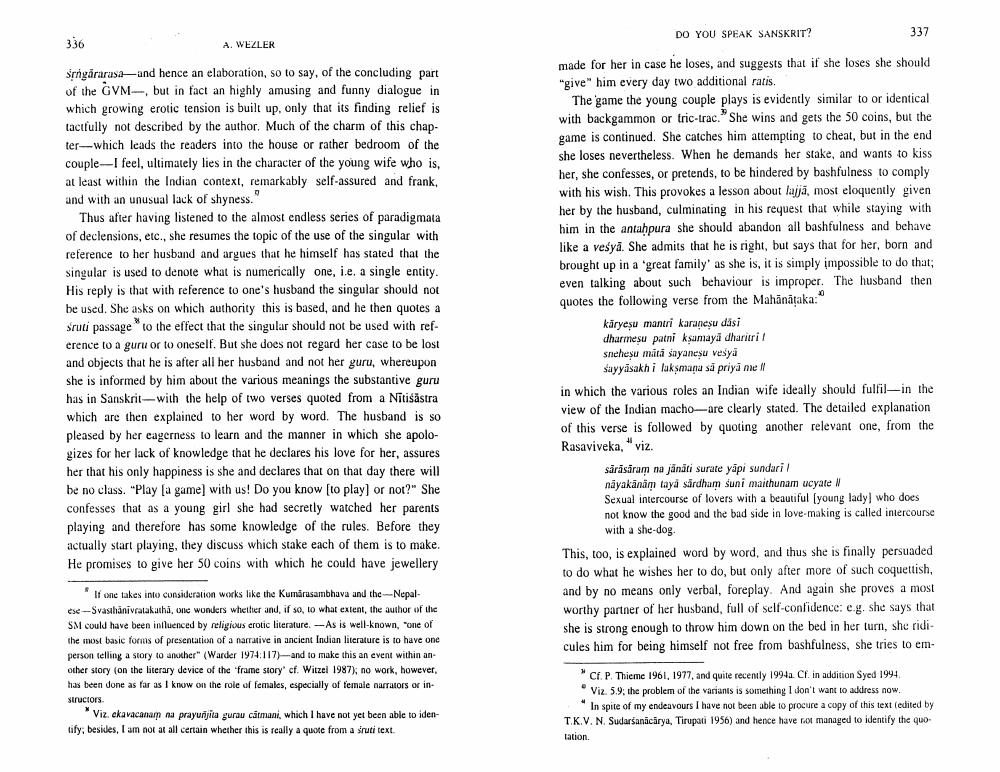________________
336
AWEZLER
DO YOU SPEAK SANSKRIT?
337
srngåraras-and hence an elaboration, so to say, of the concluding part of the GVM- but in fact an highly amusing and funny dialogue in which growing erotic tension is built up, only that its finding relief is tactfully not described by the author. Much of the charm of this chapter--which leads the readers into the house or rather bedroom of the couple--I feel, ultimately lies in the character of the young wife who is, at least within the Indian context, remarkably self-assured and frank, and with an unusual lack of shyness.
Thus after having listened to the almost endless series of paradigmata of declensions, etc., she resumes the topic of the use of the singular with reference to her husband and argues that he himself has stated that the singular is used to denote what is numerically one, i.e. a single entity. His reply is that with reference to one's husband the singular should not be used. She asks on which authority this is based, and he then quotes a Sruti passage to the effect that the singular should not be used with reference to a guru or to oneself. But she does not regard her case to be lost and objects that he is after all her husband and not her guru, whereupon she is informed by him about the various meanings the substantive guru has in Sanskrit - with the help of two verses quoted from a Nitišastra which are then explained to her word by word. The husband is so pleased by her eagerness to learn and the manner in which she apologizes for her lack of knowledge that he declares his love for her, assures her that his only happiness is she and declares that on that day there will be no class. "Play la game] with us! Do you know to play) or not?" She confesses that as a young girl she had secretly watched her parents playing and therefore has some knowledge of the rules. Before they actually start playing, they discuss which stake each of them is to make. He promises to give her 50 coins with which he could have jewellery
made for her in case he loses, and suggests that if she loses she should "give him every day two additional ratis.
The game the young couple plays is evidently similar to or identical with backgammon or tric-trac." She wins and gets the 50 coins, but the game is continued. She catches him attempting to cheat, but in the end she loses nevertheless. When he demands her stake, and wants to kiss her, she confesses, or pretends to be hindered by bashfulness to comply with his wish. This provokes a lesson about lajā, most eloquently given her by the husband, culminating in his reyuest that while staying with him in the antahpura she should abandon all bashfulness and behave like a vesya. She admits that he is right, but says that for her, born and brought up in a great family as she is, it is simply impossible to do that; even talking about such behaviour is improper. The husband then quotes the following verse from the Mahānātaka:
käryeșu mantri karanesu dási dharmesu patni ksamaya dhariri snehesu mata sayanesu veya
sayyāsakh i laksmana sa priya nel in which the various roles an Indian wife ideally should fullil-in the view of the Indian macho-are clearly stated. The detailed explanation of this verse is followed by quoting another relevant one, from the Rasaviveka, "viz.
särāsāram na jänati surate yāpi sundaril nayakānām tayá särdham suni maithunam ucyate / Sexual intercourse of lovers with a beautiful young lady who does not know the good and the bad side in love-making is called intercourse
with a she-dog. This, too, is explained word by word, and thus she is finally persuaded to do what he wishes her to do, but only after more of such coquettish, and by no means only verbal, foreplay. And again she proves a most worthy partner of her husband, full of self-confidence: e.g, she says that she is strong enough to throw him down on the bed in her turn, she ridicules him for being himself not free from bashfulness, she tries to em
If one takes into consideration works like the Kumarasambhava and the Nepalese-Svasthanivratakatha, one wunders whether and, if so, to what extent, the author of the SM could have been influenced by religious erotic literature. -As is well-known, one of the most basic forms of presentation of a narrative in ancient Indian literature is to have one person telling a story to wher" (Warder 1974 117) and to make this an event within another story on the literary device of the frame story' cf. Witzel 1987), no work, however, has been done as far as I know on the role of females, especially of female narrators or instructors
"Vizchavacanam w prayunjila gurau câtmani, which I have not yet been able to identify, besides, I am not at all certain whether this is really a quote from a sruti text.
CAP Thieme 1961, 1977, and quite recently 1994a. Cf. In addition Syed 1994 Viz. 59, the problem of the varianis is something I don't want to address now.
In spite of my endeavours I have not been able to procure a copy of this text edited by TK.V. N. Sudarsanācārya, Tirupati 1956) and hence have managed to identify the quo tation




